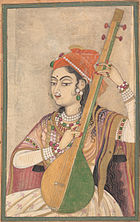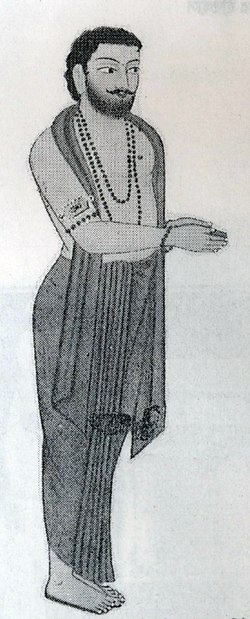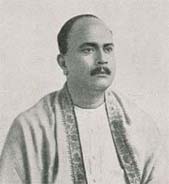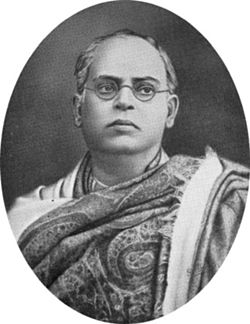Music of West Bengal
| Music of India | |
|---|---|
 A lady playing the Tanpura, c. 1735 (Rajasthan) | |
| Genres | |
Traditional
Modern | |
| Media and performance | |
| Music awards | |
| Music festivals | |
| Music media | |
| Nationalistic and patriotic songs | |
| National anthem | Jana Gana Mana |
| Regional music | |
| |
This article has multiple issues. Please help improve it or discuss these issues on the talk page. (Learn how and when to remove these template messages)
|
The music of West Bengal includes multiple indigenous musical genres such as Baul, Ramprasadi, Bishnupuri Classical, Kirtan, Shyama Sangeet, Rabindra Sangeet, Nazrul Geeti, Dwijendrageeti, Prabhat Samgiita, Agamani-Vijaya, Patua Sangeet, Gambhira, Bhatiali, Bhawaiya, Bengali Rock.
Classical music[edit]
Ragapradhan Gaan[edit]
Bengali classical music is based on modes called ragas. In composing these songs, the melodies of North Indian ragas are used. As far as the Charyagiti (9th century), ragas have been used in Bengali music. Jaydev's Gita Govinda, Padavali Kirtan, Mangal Giti, Shyama sangeet, Tappa, Brahma Sangeet and Tagore songs have been inspired by Ragas. The use of North Indian ragas in Bangla songs began in 18th century. This trend gathered momentum during the 19th and 20th centuries. The pioneers of these trend were Ramnidhi Gupta of North Kolkata, Kali Mirza of Hooghly, Raghunath Roy and the founder of the Bishnupur Gharana, Pandit Ramshanker Bhattacharya of Bankura.[1] Nawab of Lucknow, Wajid Ali Shah played an important role in this trend. He was dethroned by the British empire in 1856 and banished to Metiaburuz, Kolkata in present-day West Bengal. During his 30-year exile, he patronized music, specially dhrupad, tappa, thumri and kheyal. And, thus made a lasting impact on Bengali music. All traditional Bengali music tend to be based on various variations of Hindustani classical music. Rabindranath Tagore had a deep appreciation for north Indian ragas, successfully introduced ragas in his songs. He was followed by Dwijendralal Ray, Rajanikanta Sen and Atulprasad Sen.[2]
Bishnupur Gharana[edit]
The Bishnupur Gharana is the sole Classical (Drupad) gharana of Bengal. It originated in Bishnupur, Bankura, West Bengal by the court musicians of the Malla Kings.[3] Bahadur Khan of Delhi, a descendant of the Tansen, was the father of Bishnupur Gharana. Bahadur Khan was brought to Bishnupur by Malla King Raghunath Singha II.
Rabindra Sangeet[edit]
Rabindra Sangeet (Bengali: রবীন্দ্রসঙ্গীত Robindro shonggit, Bengali pronunciation: [ɾobindɾo ʃoŋɡit]), also known as Tagore Songs, are songs written and composed by Rabindranath Tagore.[4] They have distinctive characteristics in the music of Bengal, popular in India and Bangladesh.[5][6]
Rabindra Sangeet has been an integral part of Bengal culture for over a century.[6][7] Indian social reformer Swami Vivekananda became an admirer of Rabindra Sangeet in his youth. He also composed music in the Rabindra Sangeet style, for example Gaganer Thale in Raga Jaijaivanti.[6]
Shyama Sangeet[edit]
Shyama Sangeet(Bengali: শ্যামা সঙ্গীত) is a genre of Bengali devotional songs dedicated to the Hindu goddess Shyama or Kali which is a form of supreme universal mother-goddess Durga or parvati. It is also known as Shaktagiti or Durgastuti.[8]
Ramprasadi[edit]
Ramprasadi (Bengali : রামপ্রসাদী) is a category of Shyama Sangeet composed by eighteenth century Bengali saint-poet IAST (IAST: IAST)
(Bengali: রামপ্রসাদ সেন; c. 1718 or c. 1723 – c. 1775).[9][10] They are usually addressed to Hindu goddess Kali and written in Bengali language.[11][12][13][14]
Ramprasad Sen was the first Shakta poet to address Goddess Kali with such as intimate devotion and to sing of her as a tender loving mother or even as a little girl. Ramprasad is credited with creating a new compositional form that combined the Bengali folk style of Baul music with classical melodies and kirtan. The new style took root in Bengali culture with many poet-composers combining folk and raga-based melodies, mixing every common style of music from classical to semi-classical and folk.[15] His songs are sung today, with a popular collection—Ramprasadi Sangeet ("Songs of Ramprasad")—sold at Shakta temples and pithas in Bengal.[11] After him, a school of shakta poets continued the Kali-bhakti tradition. Krishna Chandra Roy, Siraj ud-Daulah, Rabindranath Tagore, Kazi Nazrul Islam were immensely inspired by the songs of Ramprasad.[12][13][14] Many of his songs have been sung by renowned Shyama sangeet singers of West Bengal like Dhananjay Bhattacharya, Pannalal Bhattacharya and Anup Ghoshal. These songs are still very popular in West Bengal.
Agamani-Vijaya[edit]
Agamani (Bengali: আগমনী গান Āgōmōni gān "Songs of advent") and Vijaya (বিজয়া গীতি Bījōyā gīţi "Songs of parting") are genres of Bengali folk songs celebrating the return of the Goddess Parvati to the home of her parents on the eve of the Bengali autumn festival of Durga Puja.[16][17] The Aagamani songs describe the return of Parvati to her home in rural Bengal, not as Goddess but as daughter, and are followed by Vijaya songs which describe the sorrow of separation three days later as Parvati returns to her husband Shiva.
Atulprasadi[edit]
Atulprasadi (Bengali: অতুলপ্রসাদী) or the Songs of Atulprasad Sen (1871–1934), one of the major lyricist and composers of early-modern period, is also widely popular in Pachimbanga.[18] Atul Prasad is credited with introducing the Thumri style in Bengali music.[18] His songs centred on three broad subjects – patriotism, devotion and love.[18]
Dwijendrageeti[edit]
Dwijendrageeti (Bengali: দ্বিজেন্দ্রগীতি) or the Songs of Dwijendra Lal Roy (1863–1913), which number over 500, create a separate subgenre of Bengali music. The patriotic songs of Dwijendra Lal Roy are very popular in West Bengal.
Prabhati Sangeet[edit]
Prabhati Sangeet (Bengali: প্রভাতী সঙ্গীত Probhati Shongit, Bengali pronunciation: [pɾɔbhat ʃɔŋɡit] – see spelling variations Prabhati Sangeet, also known as Songs of a New Dawn and Prabhat Songs, are songs composed by Prabhat Ranjan Sarkar.[19] Sarkar composed a total of 5,018 songs, including the lyrics and the tune, in a period of eight years from 1982 until his death in 1990,[20] making using of eight different languages: Bengali, Hindi, English, Sanskrit, Urdu, Magahi, Maithili and Angika.[21]
Patua Sangeet[edit]
Patua Sangeet or Poter Gan is a cultural tradition of Bengal Patachitra in West Bengal. It is performed by the Patuas.[22] It is famous in the southern and south-western districts of West Bengal like Birbhum, Jhargram, Bardhaman and Murshidabad as folk song.[23] There are three types of Patua Sangeet according to the difference of Patachitra and the mythological stories associated with it. This lyrical drama written about the Krishno leela, Gourango Leela, Ram Leela, Shib-Parboti Lila etc., is called Leela kahini. Gopalan or Cattlefarming story is another type of Patua Sangeet.[24]
Gombhira[edit]
In West Bengal, gombhira performances are centred around the Malda District in Northern part of West Bengal. It is performed with a particularly distinctive rhythm and dance with two performers, always personifying a man and his maternal grandfather, discussing a topic to raise social awareness. The Gambhira dance along with Gambhira Song is performed all over the Malda district of North Bengal during the festival of Chaitra Sankranti. For this festival Gambhira masks are made out of neem and fig trees by the local Sutradhar community. Sometimes the masks are also made out of clay.[25] Gambhira dance is performed along with Gombhira song wearing these masks. The songs of Gambhira originated among the Hindu community of Maldah in West Bengal, completely in its theme formation.[26]
Bhadu Gaan[edit]
Bhadu is a social festival of South-Western part of West Bengal. The festival starts from the first day of Bhadro, the fifth month in Bengali Calendar and continues till the end of the month. Bhadu gaan, an inseparable part of Bhadu festival reflects the colours of rural society. It is popular in Purulia, Paschim Bardhaman, Bankura, Paschim Midnapore and Birbhum districts of West Bengal. Bhadu songs are composed extemporaneously and sung on each night of the festival, depicts the Goddesses as young girls. They describe Bhadu and tell in loving detail how they will be entertained. Since Bhadu is unmarried, her songs are sung mostly by unmarried girls. Dancing and playing drums accompanies Bhadu. [27]
Tusu Gaan[edit]
Tusu is a folk festival held on the last day of the Bengali month of Poush. It is a unifying form of local common faith and the joy of the harvest. Tusu is a cosmic goddess and conceived as a virgin girl, who imagined as a young girl and is worshipped by Tusu song improvised by womenfolk, based on popular beliefs as well as rituals associated with harvesting. At the end of the festivities, the immersion of the image of Tusu is done vividly and with Tusu songs which have a melancholic ring.[28] Tusu puja is practised and Tusu songs are sung in the rural areas of Bankura, Purulia, Bardhaman and Hooghly districts of West Bengal.[28]
Jhumur[edit]
This type of folk song is very popular in Purulia, Birbhum, Bankura, Purba Midnapur and Paschim Medinipur districts of West Bengal.
Bolan Gaan[edit]
Bolan or Bolan Gaan is a type of folk song of West Bengal which was once very popular in large areas of Birbhum, Nadia, Burdwan and Murshidabad districts of West Bengal.[29]
Bhawaiya[edit]
Bhawaiya is a musical form or a popular folk music that originated in Northern Bengal, especially in Cooch Behar district of West Bengal, India, Goalpara district of Assam, India and Rangpur Division in Bangladesh.[30][31][32] A "working class" music, with the recurring figures of mahouts(মাহুত) (elephant trainers and catchers), mahishals (মইষাল)(buffalo herders) and gariyals(গাড়িয়াল)(cart drivers) the lyrics of these songs express pangs of separation and loneliness of their womenfolk,[33] with elongated tones accentuating pain, longing and "deep emotion".[34] Generally believed to have originated in the 16th century under the Koch king Vishwa Singha,[35] it has evolved into stage performances since the 1950s and more widely since the 1990s. The lyrics of Bhawaiya songs are non-denominational.[36]
Bhatiali[edit]
Bhatiali or bhatiyali (Bengali: ভাটিয়ালি) is a form of folk music in both West Bengal and Bangladesh. Bhatiali is a river song mostly sung by boatmen while going down streams of the river. The word bhatiyali comes from bhata meaning "ebb" or downstream.[37]
Alkap[edit]
Alkap (Bengali: আলকাপ) is a form of Bengali folk performance popular in the districts of Murshidabad, Malda and Birbhum in West Bengal.[38][39]
Band music and Bengali rock[edit]
Popular Rock Bands
| Year formed | Band name | Genre | Language |
|---|---|---|---|
| 1975 | Moheener Ghoraguli | Bengali rock | Bengali |
| 1990 | Krosswindz | Bengali rock, fusion | Bengali, English, Hindi |
| 1991 | Chandrabindoo | Bengali rock | Bengali |
| 1992 | Cactus | Bengali rock, hard rock | Bengali |
| 1996 | Hip Pocket | Rock, hard rock | English |
| 1998 | Fossils | Bengali rock, hard rock, metal | Bengali, English, Hindi |
| 1998 | Kalpurush[40] | Bengali Rock, Bengali Pop, Rock, Pop | Bengali, Hindi |
| 1999 | Bhoomi | Bengali rock | Bengali |
| 1999 | Skinny Alley | Rock, alternative rock | English |
| 1999 | Lakkhichhara | Bengali rock | Bengali |
| 2001 | Cassini's Division | Rock, alternative rock | English |
| 2002 | Insomnia | Bengali rock, alternative, nu metal | English, Bengali |
| 2005 | Rikterskale | Bangla Rock | |
| 2005 | Prithibi | Bengali rock | Bengali |
| 2005 | Agnish | Bengali Rock, Hard rock, Rock n Roll | Bengali |
| 2005 | Calcutta Blues | Bengali rock | Bengali |
| 2006 | Destiny[41] | Progressive, neo-classical | |
| 2006 | Pinknoise | Experimental rock, alternative rock | English |
| 2006 | Pseudonym | Alternative rock, hard rock | English |
| 2006 | Kanvas | Alternative rock, Folk rock | Bengali, Hindi |
| 2007 | Five Little Indians | Alternative rock | English |
| 2008 | soul unity of rhythm | Alternative rock | Bengali |
| 2009 | Kendraka | Jazz rock | |
| 2010 | Underground Authority | Alternative rock, rap rock, hard rock | Hindi, English, Bengali |
| 2012 | RobiONobin | Folk rock | |
| 2013 | Lotus Eater | Country, Alternative rock, rap rock soft rock, folk fusion, rock 'n' roll | Hindi, English, Bengali https://web.archive.org/web/20150218104000/http://www.fruithuntt.com/lotus-eater/ |
| 2014 | Cross Chords | Experimental Rock, Progressive Rock, Metal | Bengali, English |
| Parama[40] | |||
| Aurko[40] | |||
| 2015 | the troubadours | Folk, Blues, mainly known for their Protest songs, such as 'Raasta ta howa dorkar' | Bengali, English |
Rock at Someplace Else (Kolkata)[edit]
Someplace Else is a pub in Kolkata which features daily performances by live bands. Since 1994 it has been promoting different kinds of music, and established artists share the space with aspiring performers. The pub is situated inside the Park Hotel, and regarded as a heritage spot of the city. Famous bands like Skinny Alley, Hip Pocket (a regular band), Lou Majaw, Prestorika, Parikrama, Indian Ocean, Soulmate, Cassini's Division, Underground Authority, The Supersonics and many international musical acts have performed in this pub.[42] International artists like Mumford & Sons, Laura Marling, QED (band), Dub FX and many more have performed in this pub. The pub hosts 3285 hours of live music every year, the most anywhere in India (approximately nine hours of live music daily).
Daily Bands[edit]
| Day | Bands |
|---|---|
| Monday | Open Mind (Open Mic Session) and Guest Band |
| Tuesday | Krosswindz |
| Wednesday | Hip Pocket and Pseudonym |
| Thursday | Span |
| Friday | Hip Pocket and Insomnia |
| Saturday | Guest Band and Saturday Night Blues |
| Sunday | Orient Express and Crystal Grass |
See also[edit]
- Tamang Selo
- Bengali folk literature
- Culture of Bengal
- Culture of West Bengal
- Music of Bangladesh
- Music of Bengal
- Baul
- Nazrul Geeti
References[edit]
- ↑ "Classical Music of Bengal". www.onlineradiobox.com. Retrieved 21 January 2019.
- ↑ "Bangla Classical Music Festival". www.banglaclassicalmusicfest.com. Retrieved 20 January 2019.
- ↑ "Culture of Bishnupur". Archived from the original on 5 February 2012. Retrieved 5 December 2011.
- ↑ Sigi, Rekha (2006). Gurudev Ravindra Nath Tagore A Biography. Diamond Pocket Books (P) Ltd. p. 90. ISBN 978-81-89182-90-8.
- ↑ Tagore, Rabindranath (2007). Boyhood Days. Penguin Books India. p. xii. ISBN 978-0-14-333021-9.
- ↑ 6.0 6.1 6.2 "Magic of Rabindra Sangeet". Deccan Herald. Archived from the original on 9 July 2013. Retrieved 9 July 2013.
- ↑ Dasgupta, Sanjukta; Guha, Chinmoy (2013). Tagore-At Home in the World. SAGE Publications. p. 252. ISBN 978-81-321-1084-2.
- ↑ Sayeed, Khan Md (2012). "Shyamasangit". In Islam, Sirajul; Jamal, Ahmed A. (eds.). Banglapedia: National Encyclopedia of Bangladesh (Second ed.). Asiatic Society of Bangladesh.
- ↑ Martin 2003, p. 191
- ↑ Ayyappapanicker 1997, p. 64
- ↑ 11.0 11.1 McDaniel 2004, p. 162
- ↑ 12.0 12.1 "রামপ্রসাদের ভিটেয় কালীর কদর যেমন, সাধককবির আদরও ততটাই!". EI Samay (in Bengali). Retrieved 28 August 2020.
- ↑ 13.0 13.1 Singing to the Goddess: Poems to Kali and Uma from Bengal, Ramprasad Sen, Translated by Rachel Fell McDermott (ISBN 0-19-513434-6)
- ↑ 14.0 14.1 History of Bengali Literature, Dr. Dulal Chakraborty, July – 2007, Bani Bitan. (Bengali)
- ↑ Arnold, Alison, ed. (2000). The Garland Encyclopedia of World Music. Taylor & Francis. p. 846. ISBN 978-0-8240-4946-1.
- ↑ Datta 2006, p. 95
- ↑ Bhowmik 2012
- ↑ 18.0 18.1 18.2 Arnold, Alison (2000). The Garland Encyclopedia of World Music. Taylor & Francis. p. 851. ISBN 0-8240-4946-2.
- ↑ Subramanya, Mysore V. (17 March 2008). "DANCE/MUSIC REVIEW – Prabhat Sangeeth". Deccan Herald. Archived from the original on 12 October 2013. Retrieved 1 February 2013.
- ↑ "Homage to spiritual guru". Calcutta, India: The Telegraph (Calcutta). 20 September 2004. Retrieved 1 February 2013.
- ↑ Sarkar, Subhas (31 December 2010). Prabháta Samgiita: A Literary and Philosophical Appreciation (First ed.). Ananda Marga Publications. ISBN 978-81-7252-260-5. OCLC 704229361.
- ↑ Sri Ashutosh Bhattacharya. Bangiyo Loko-Sangeet Ratnakosh. Kolkata: Paschimbanga Loko Sanskriti Gobeshona Kendra. p. 1041.
- ↑ "Myths and Folktales in the Patachitra Art of Bengal: Tradition and Modernity – The Chitrolekha Journal on Art and Design". The Chitrolekha Journal on Art and Design. 2 August 2015. Retrieved 18 May 2018.
- ↑ Gurusaday Dutta (1939). Patua Sangeet. Kolkata: Kolkata University. pp. Introduction page.
- ↑ "The Mask". Biswa Bangla. Retrieved 13 February 2018.
- ↑ http://www.indianetzone.com/18/gambhira_dance_west_bengal.htm
- ↑ Peter J Claus; Sarah Diamond; Margaret Ann Mills (2003). "South Asian Folklore: An Encyclopedia : Afghanistan, Bangladesh, India, Nepal, Pakistan, Sri Lanka". Taylor & Francis. p. 567. ISBN 0415939194.
- ↑ 28.0 28.1 Anjalika Mukhopadhyay (2012). "Tusu Festival". In Islam, Sirajul; Miah, Sajahan; Khanam, Mahfuza; Ahmed, Sabbir (eds.). Banglapedia: the National Encyclopedia of Bangladesh (Online ed.). Dhaka, Bangladesh: Banglapedia Trust, Asiatic Society of Bangladesh. ISBN 984-32-0576-6. OCLC 52727562. Retrieved 1 November 2025.
- ↑ "লুপ্তপ্রায় বোলান গানের ভবিষ্যৎ কী, প্রশ্ন মঞ্চে".
- ↑ Rahman, Urmi. (2014). Bangladesh – culture smart! : the essential guide to customs & culture. Kuperard. p. 121. ISBN 978-1-85733-696-2. OCLC 883354783.
- ↑ Ahmed, A. F. Salahuddin; Chowdhury, Bazlul Mobin (2004). Bangladesh, national culture, and heritage : an introductory reader. University of Michigan. p. 407. ISBN 984-8509-00-3. OCLC 56598621.
- ↑ Khāna, Mobāraka Hosena (1988). Music and its study. New Delhi: Sterling Publishers. p. 69. ISBN 81-207-0764-8. OCLC 18947640.
- ↑ (T)he popular image that the term bhawaiya still conjures up is a form of plaintive ballads that speak of love and loss and endless longing within a woman's heart. Dutta 2019
- ↑ Sarma & Monteiro 2019, p. 332
- ↑ There is an approximate consensus that the origins of the form may be dated back to at least the sixteenth century, during the reign of Raja Bishwa Sinha, who established the kingdom of Koch Bihar.Dutta 2019
- ↑ (B)hawaiya developed as an integral cultural expression of the Rajbanshis, and these songs are composed in Rajbanshi (or Kamrupi or Kamtapuri), the most widely spoken Bengali dialect across this belt. Despite the influence of Brahminical Hinduism, Islam and Vaishnavism over the preceding centuries, the popular culture of these communities have retained matriarchal influences, evident from the many extant folk rituals and practices. Dutta 2019
- ↑ "Bhatiyali Folk Song in India". India9.com. Retrieved 15 June 2017.
- ↑ Ahmed, Wakil. "Alkap Gan". Banglapedia. Asiatic Society of Bangladesh. Retrieved 22 March 2009.
- ↑ "Sudkhor". The Telegraph, 18 July 2003. Retrieved 22 March 2009.
- ↑ 40.0 40.1 40.2 "Mirchi Sarod Sandhya comes rocking!". The Times of India. Archived from the original on 7 September 2013.
- ↑ "Kolkata Bangla Band DESTINY - Songs & Interview with Band Members". Washington Bangla Radio. 26 August 2011. Retrieved 27 April 2018.
- ↑ "Someplace Else, Kolkata – Rock Bands". The Times of India. Calcutta. 25 June 2011.
Bibliography[edit]
- Ayyappapanicker, K. (1997). Medieval Indian Literature: Surveys and selections. Sahitya Akademi. p. 64. ISBN 978-81-260-0365-5.
- Bhowmik, Dulal (2012). "Agamani-vijaya". In Islam, Sirajul; Jamal, Ahmed A. (eds.). Banglapedia: National Encyclopedia of Bangladesh (Second ed.). Asiatic Society of Bangladesh.
- Datta, Amaresh (2006). The Encyclopaedia Of Indian Literature Vol 1. Sahitya Akademi. ISBN 81-260-1803-8.
- Dutta, Soumik (24 December 2019). "The Solitude of Love: Nature, Culture and Womanhood in Bhawaiya Songs". Sahapedia. Archived from the original on 6 July 2020. Retrieved 6 July 2020.
- Martin, Nancy M. (2003). "North Indian Hindi Devotional Literature". In Gavin D. Flood (ed.). The Blackwell companion to Hinduism. Wiley-Blackwell. ISBN 978-0-631-21535-6.
- McDaniel, June (2004). Offering Flowers, Feeding Skulls. Oxford University Press. ISBN 978-0-19-516790-0.
- Sarma, Simona; Monteiro (2019). "Contemporary 'Folk' Dynamics: Shifting Visions and Meanings in the Goalpariya Folk Music of Assam". Folklore. 130 (4): 331–351. doi:10.1080/0015587X.2019.1622923. S2CID 213283007.



